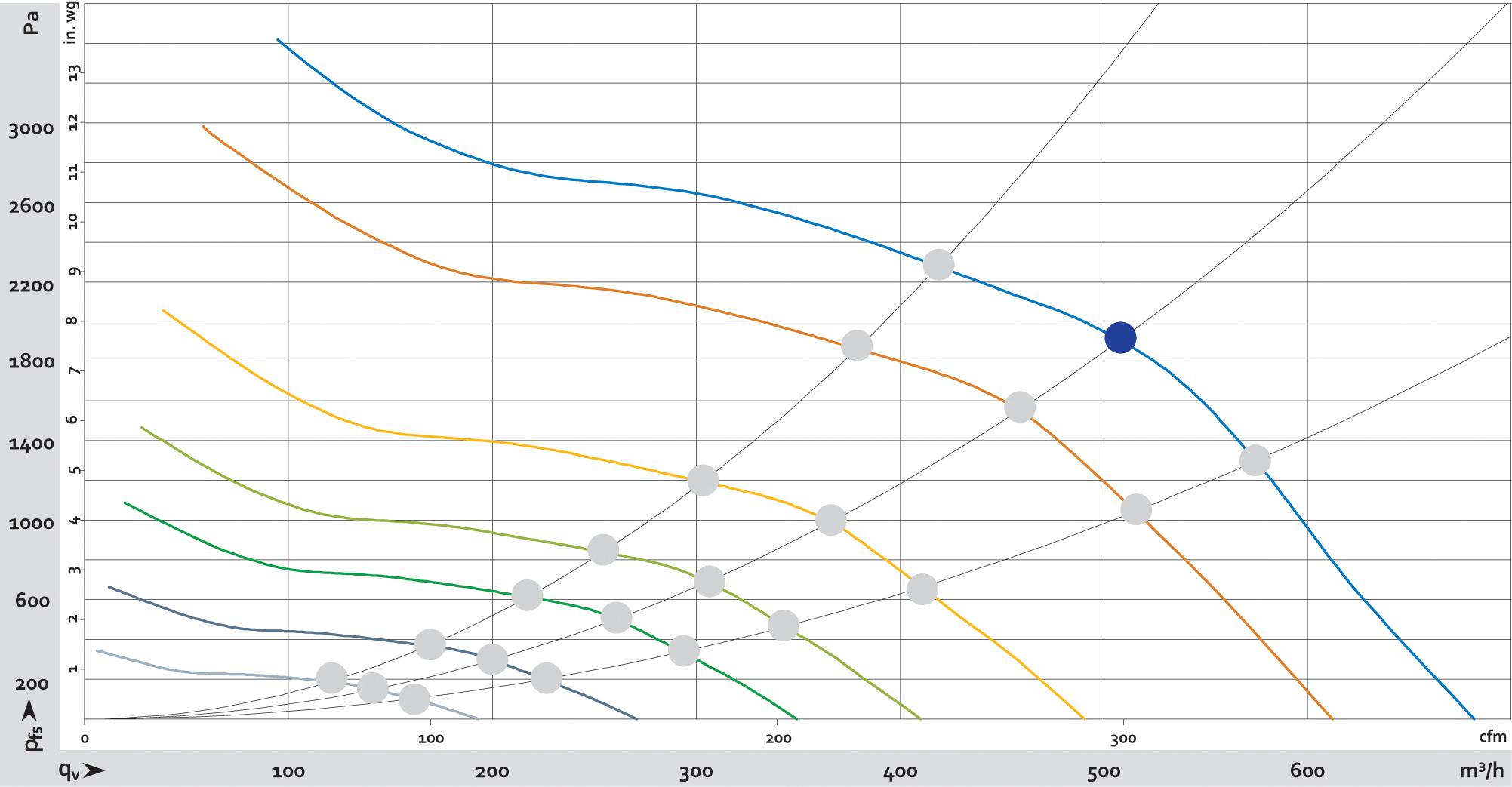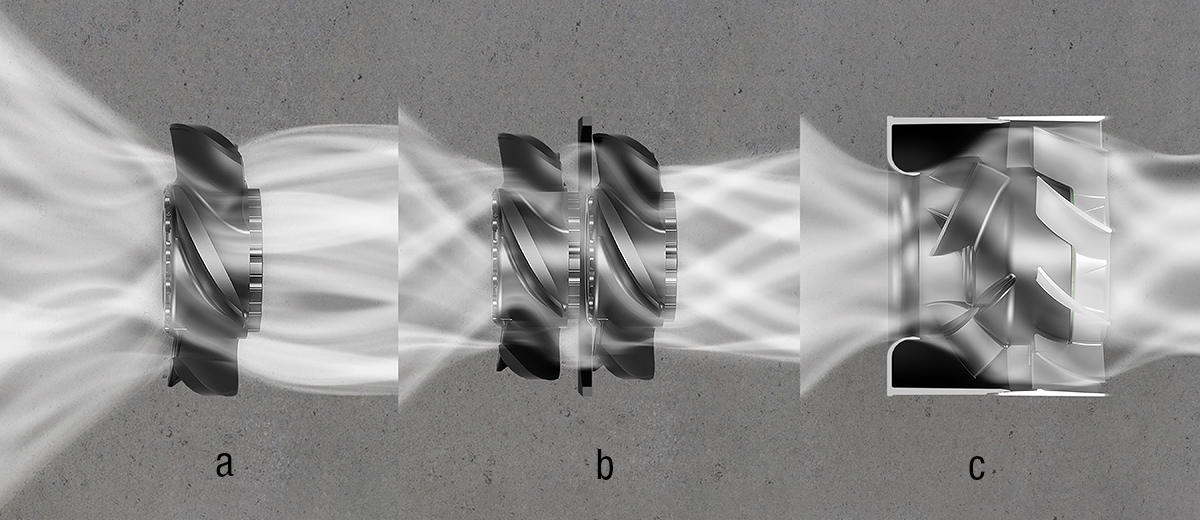Today, electronics cooling is mainly based on axial compact fans, especially because they are easy to integrate and deliver high air flow rates thanks to the principles involved. However, axial compact fans have their limits, for example if ever-more powerful electronics are housed in the same space or have to be made even more compact in telecommunications systems or data centers (Fig. above).
To increase the cooling capacity, two axial compact fans are simply connected in series, which, in practice, is usually achieved using counter-rotating rotors. This kind of two-stage fan design results in a higher pressure in principle, but the system also has significantly higher noise levels. This means that it doesn’t fulfill standards and guidelines for noise protection, such as those from NEBS (Network Equipment Building System), OSHA (Occupational Safety and Health Administration), ANSI (American National Standards Institute) or ETSI (European Telecommunications Standards Institute). Additional noise reduction is generally not an option, as it requires too much space and drives up the costs.
New development approach for a convincing solution

Fig. 1: Compared to a conventional fan solution, the new DiaForce delivers up to 50% more air performance and also generates significantly less noise. (Photo | ebm-papst)
So the specialists at ebm-papst chose a new approach to develop a fan that delivers more power without being louder and yet is compact. The St. Georgen, Mulfingen and Shanghai sites pooled their expertise. In close consultation with a major electronics manufacturer, the DiaForce (Fig. 1) was developed, a new compact fan that can meet the future requirements of electronics cooling in all respects and whose dimensions are the same as a conventional two-stage solution.
The concept behind the new development is convincing, but the DiaForce’s secret lies in the unique geometry of its impeller and housing. This minimizes turbulence in the edge area, resulting in a significant reduction in noise. The fan impeller’s outlet opening is also larger than the intake opening. This means that air flows through the fan in both an axial and radial direction, which ensures a high pressure increase (Fig. 2).
Therefore, the DiaForce is characterized as being between an axial and a centrifugal fan. The basic axial design, which is cheaper to install, remains. A particular advantage in terms of aerodynamics is that the DiaForce offers an air performance curve with no dip. At the same time, aerodynamic optimizations make it the quietest fan with this power density (Fig. 3).

Fig. 2: The typical pressure increase in the DiaForce: at the operating point marked blue in the example, the DiaForce reaches over 17,000 rpm with a power consumption of 516 W. This results in over 1,800 Pa in pressure and >500 m³/h in air performance. (ebm-papst)
The compact fan has up to 6 dB(A) lower noise emissions than a conventional axial compact fan and has up to 50% higher air performance. The higher air performance is often not required in normal operation, as fans that cool electronics often operate at partial load. However, a sufficient power reserve is crucial to ensuring that the electronics continue to function sufficiently under conditions outside normal operation. For example, if the air conditioning in the room is faulty and the ambient temperature rises, there’s enough of a reserve available to speed up the fan as required.
Powerful and intelligent DC motor
The developers have also taken an important step with the motorization. The driving force behind the compact fan is a three-strand, energy-efficient DC motor with a motor power of 500 W. The motor design is very compact and operates at high efficiency. The newly developed 500 W electronics have a lot to offer: a powerful microcontroller is at the heart of the intelligent motor regulation. It enables maximum possible torque in all load ranges and provides optimum efficiency and structure-borne noise. The integrated locked-rotor protection ensures safety. A configurable control input and various optional output signals are available as interfaces. Practical options include a signal go/no go alarm, an alarm with a speed limit, and an internal or external temperature sensor. The DiaForce is now available in size 120×120 x86 mm.

Fig. 3: A direct comparison between a single-stage axial compact fan (a), a two-stage axial compact fan (b) and the new DiaForce diagonal compact fan (c). (Photo | ebm-papst)
Intelligent maintenance concepts with FanCheck
The optional FanCheck function also enables intelligent maintenance concepts to be implemented: Fans are usually replaced unexpectedly when they fail. If the fans cool electronics that have high availability requirements, such as in data centers or mobile communication base stations, they have to be replaced very quickly. Some service concepts also stipulate that all the fans in the system have to be replaced if this happens. This often leads to significant outlay because of material costs and because service technicians have to travel to installation sites. The FanCheck function from ebm-papst solves this problem.
FanCheck continuously calculates the statistical service life of the fan during operation based on the actual operating conditions.
This allows the replacement process to be planned cost-effectively and enables reduced replacement costs. In addition, it increases the availability of the devices. The customer can specify at which time and in which way the fan is to provide status information or warnings. It can monitor the remaining service life closely or trigger a simple alarm when the remaining service life goes below a previously set value. In this way, FanCheck can be easily integrated into existing control systems. This means that there’s nothing standing in the way of “intelligent” and high-performance electronics cooling, as set out by GreenIntelligence, for information and communication technology in future.
GreenIntelligence
When it comes to choosing the right drive or fan, it’s not just product characteristics, such as energy efficiency and performance values, that are crucial but also the intelligence and communication options that have been implemented. Examples of GreenIntelligence solutions for ventilation and drive technology include data acquisition using internal and external sensors, data processing, intelligent regulation of high-performance motor control systems and options for integrating the system into networks.
Thanks to condition monitoring, users can keep an eye on the operating parameters of their system at any time and carry out a better error analysis and optimization because the operating history is documented. Demand-oriented and predictive operation enables longer operating times, minimizing energy consumption and noise generation, and self-regulating at different operating states. Predictive maintenance allows needs-based service work to be planned so that longer service intervals and high availability can be achieved with a low number of downtimes.

Leave a comment